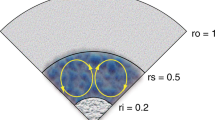Abstract
Galileo mission detected the magnetic anomalies originated from Galilean moons. These anomalies are likely generated in the moons’ interiors, under the influence of a strong ambient Jovian field. Among various possible generation mechanisms of the anomalies, we focus on magneto-convection and dynamos in the interiors via numerical simulation. To mimic the electromagnetic environment of the moons, we introduce in our numerical model an external uniform magnetic field B 0 with a fixed orientation but varying field strength. Our results show that a finite B 0 can substantially alter the dynamo processes inside the core. When the ambient field strength B 0 increases to approximately 40% of the field generated by the pure dynamo action, the convective state in the core changes significantly: the convective flow decreases by 80% in magnitude, but the differential rotation becomes stronger in much of the fluid layer, leading to a stronger field generated in the core. The field morphologies inside the core tend to align with the ambient field, while the flow patterns show the symmetry-breaking effect under the influence of B 0. Furthermore, the generated field tends to be temporally more stable.
Similar content being viewed by others
References
Showman A P, Malhotra R. The Galilean satellites. Science, 1999, 286: 77–84
Khurana K K, Kivelson M G, et al. Induced magnetic fields as evidence for subsurface oceans in Europa and Callisto. Nature, 1998, 395: 777–780
Saur J, Neubauer F M, et al. Interpretation of Galileo’s Io plasma and filed observations: I0, I24 and I27 flybys and close polar passes. J Geophys Res, 2002, 107: 1422–1439
Schubert G, Zhang K K, et al. The magnetic field and internal structure of Ganymede. Nature, 1996, 384: 544–545
Kivelson M G, Khurana K K, et al. Europa and Callisto: Induced or intrinsic magnetic fields in a periodically varying plasma environment. J Geophys Res, 1999, 104: 4609–4625
Kivelson M G, Khurana K K, et al. Discovery of Ganymede’s magnetic field by the Galileo spacecraft. Nature, 1996, 384: 537–541
Zimmer C, Khurana K K, Kivelson M G. Subsurface oceans on Europa and Callisto: Constraints from Galileo magnetometer observations. Icarus, 2000, 147: 329–347
Kivelson M G, Khurana K K. Galileo magnetometer measurements: A stronger case for a subsurface ocean at Europa. Science, 2000, 289: 1340–1343
Jiao L G, Kuang W J, Ma S Z. Magnetic anomalies observed by Galilean satellites and interpretations (in Chinese). Prog Geophys, 2010, 25: 1259–1272
Kuang W J, Bloxham J. An Earth-like numerical dynamo model. Nature, 1997, 389: 371–374
Kuang W J, Bloxham J. Numerical modeling of magnetohydrodynamic convection in a rapidly rotating spherical shell: Weak and strong field dynamo action. J Comput Phys, 1999, 153: 51–81
Kuang W J, Chao B F. Topographic core-mantle coupling in geodynamo modeling. Geophys Res Lett, 2001, 28: 1871–1874
Stanley S, Bloxham J. Numerical dynamo models of Uranus’ and Neptune’s magnetic fields. Icarus, 2006, 184: 556–572
Kuang W J, Jiang W Y, Wang T Y. Sudden termination of Martian dynamo?: Implications from subcritical dynamo simulations. Geophys Res Lett, 2008, 35: 14204–14208
Wang T Y, Kuang W J, Ma S Z. Numerical simulation of Martian historical dynamo: Impact of the Rayleigh number on the dynamo state. Sci China Ser D-Earth Sci, 2009, 52: 402–410
Kuang W J. Force balances and convective state in the earth’s core. Phys Earth Planet Inter, 1999, 116: 65–79
Taylor J B. The magneto-hydrodynamics of a rotating fluid and the Earth’s dynamo problem. Proc R Soc Lon Ser A, 1963, 274: 274–283
Chandrasekhar S. Hydrodynamic and Hydromagnetic Stability. New York: Dover Publications, 1981
Kivelson M G, Khurana K K, Volwerk M. The permanent and inductive magnetic moments of Ganymede. Icarus, 2002, 157: 507–522
Sarson G R, Jones C A, Zhang K K. Dynamo action in a uniform ambient field. Phys Earth Planet Inter, 1999, 111: 47–68
Bullard E C, Freedman C, et al. The westward drift of the Earth’s magnetic field. Philos Trans R Soc Lond, 1950, A243: 67–92
Stevenson D J. Planetary magnetic fields. Earth Planet Sci Lett, 2003, 208: 1–11
Bland M T, Showman A P, Tobie G. The production of Ganymede’s magnetic field. Icarus, 2008, 198: 384–399
Glatzmaier G A. Geodynamo simulation-How realistic are they? Annu Rev Earth Planet Sci, 2002, 30: 237–257
Tyler R H. Strong ocean tidal flow and heating on moons of the outer planets. Nature, 2008, 456: 770–773
Author information
Authors and Affiliations
Corresponding author
Rights and permissions
About this article
Cite this article
Jiao, L., Kuang, W. & Ma, S. Numerical simulations on origin of Galilean moons’ magnetic anomalies. Sci. China Earth Sci. 54, 1754–1760 (2011). https://doi.org/10.1007/s11430-011-4276-0
Received:
Accepted:
Published:
Issue Date:
DOI: https://doi.org/10.1007/s11430-011-4276-0




